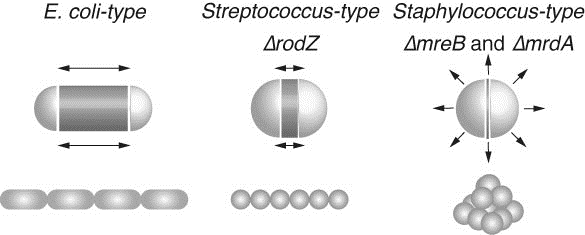Recovery of rod-shaped cells by delayed cell division
Microbial Genetics Laboratory • Niki Group
Daisuke Shiomi, Hironori Niki
MicrobiologyOpen (DOI: 10.1002/mbo3.116)
RodZ is important for maintaining the rod shape of Escherichia coli. Loss of RodZ causes conversion of the rod shape to a round shape and a growth rate slower than that of wild-type cells. Suppressor mutations that simultaneously restore both the growth rates and the rod shape were isolated. Most of the suppressor mutations are found in mreB, mrdA, or mrdB. One of the mutations was in the promoter region of zipA, which encodes a crucial component of the cell division machinery. In this study, we investigated the mechanism of the suppression by this mutation. ZipA was slightly but significantly increased in the suppressor cells and led to a delay in cell division. While round-shaped mreB and mrdA mutants lose cell bipolarity, we found that round-shaped rodZ mutants retained cell bipolarity. Therefore, we concluded that a delay in the completion of septation provides extra time to elongate the cell laterally so that the zipA suppressor mutant is able to recover its ovoid or rod shape. The suppression by zipA demonstrates that the regulation of timing of septation potentially contributes to the conversion of morphology in bacterial cells.
This study has been carried out as collaboration with Dr. Ogura at Tohoku University.

Rod shaped E. coli cells grow at the central cylinder. Ovoid shaped Streptococcus cells grow at septum while round shaped Staphylococcus cells swell. Black arrows indicate the direction of increase of cell volume. The increase in cell volume of ΔrodZ resembles that of Streptococcus, while those of ΔmreB or ΔmrdA resemble that of Staphylococcus. Dark gray zones indicate regions where peptidoglycan is actively synthesized. E. coli (WT), ΔrodZ, and Streptococcus cells retain cell polarity, while E. coli ΔmreB, ΔmrdA, and Staphylococcus cells lose polarity.















